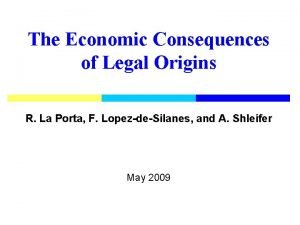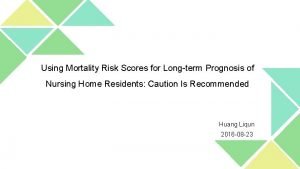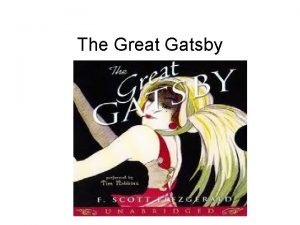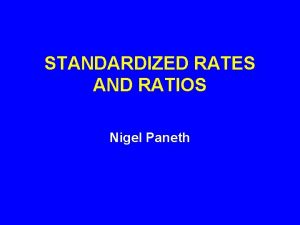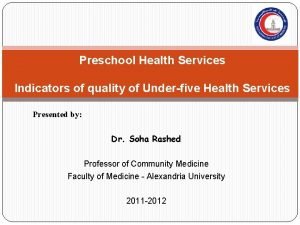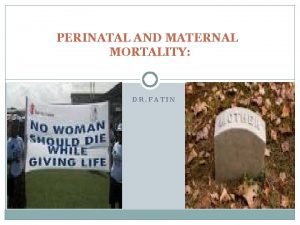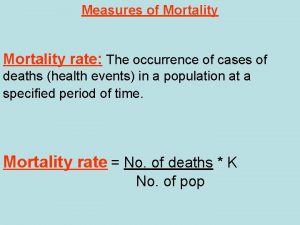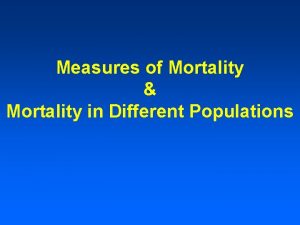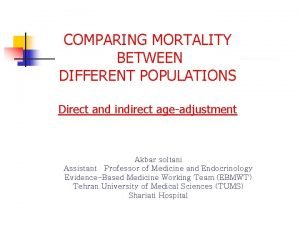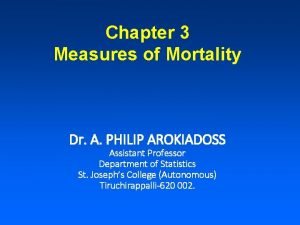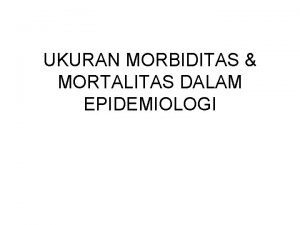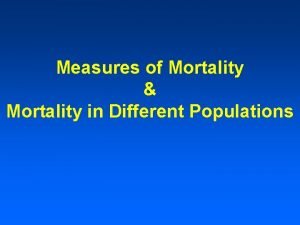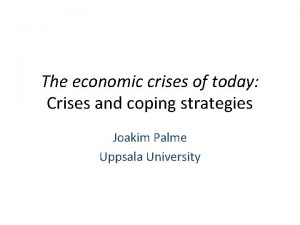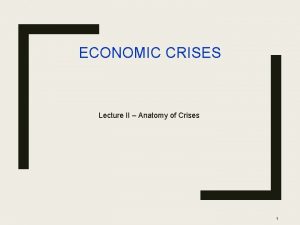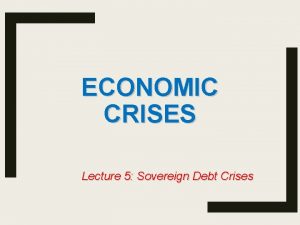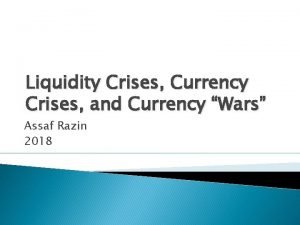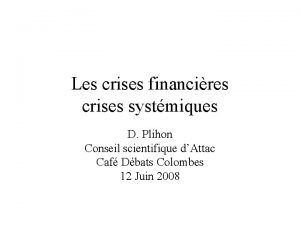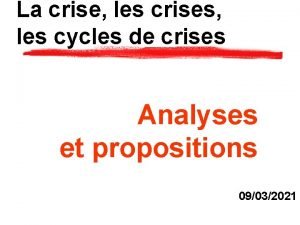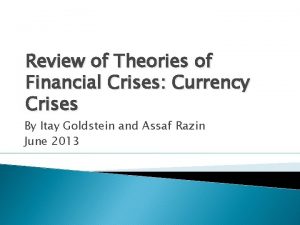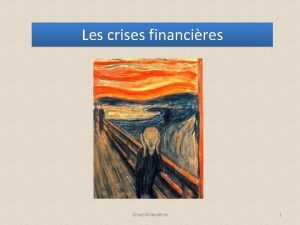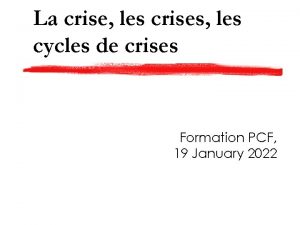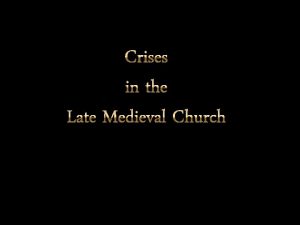Demographic and economic consequences of mortality crises in


















- Slides: 18

Demographic and economic consequences of mortality crises in pre-modern Europe Does agent-based simulation help to gain new insights into the course of recovery-from-desaster processes? Ulf Christian Ewert, Mathias Roehl and Adelinde Uhrmacher Max Planck Institute for Demographic Research Doberaner Str. 114 D-18057 Rostock Germany University of Rostock, Department of Computer Science, Research Group Modelling and Simulation Albert-Einstein-Straße 21 D-18059 Rostock Germany

Historical Modern representation scientific representation of Definition the topic Mortality crisis is a decline of population that is Þ mortality induced, Þ excessive, Þ rapid, Þ has presumably negative demographic and economic consequences „Die erschreckliche Wasser-Fluth. ” [The horrible storm tide], taken from Happel, „Die größten Denkwürdigkeiten der Welt”, 1683.

Causes of mortality crises � What are causes of mortality crises? Þ epidemics, famines, natural desasters, wars Û mortality crisis is a structural element of the history of pre-modern Europe! � Selected example: The Low Countries during late Middle Ages Þ bubonic plagues (1348, 1400) Þ famines (1315/17; 1407/08; 1437/40) Þ heavy storm tides (1362; 1436) Þ casualities of war (“the Hundred Year’s War”) Þ local desasters (fire in Lille, 1400)

Consequences of mortality crises � What sort of consequences do we expect? Þ demographic consequences: sharp fertility decline (increase in fertility) distortion of age and sex ratios Þ economic consequences: paralysis of local markets sharp increase in food prices increase of nominal wages (per capita income) Þ cultural consequences: superstitions anticipation of apocalypse

Causal model � Causal interactions closing the town; construction of dikes; defending the town precautionary measures attracting in-migration abolishing marriage regulations intervening in market processes crisis management starting job-creation programmes crisis management having grain in stock precautionary measures

Focus of the analysis � What is the focus when studying mortality crises? Þ analysis of the course of the recovery process Þ assessment of effects of distorted age and sex ratios Þ judgement of the role of crisis management in overcoming negative consequences of the crisis � Why can the study of mortality crises be useful for today’s Demography? Þ comparison to consequences of current desasters in developing countries

Appropriateness of agent-based modelling � Why agent-based modelling is appropriate to study such crises? Þ trade-off between historical accuracy and structural simplicity Û agent-based modelling enables to distinguish several sorts of reaction patterns to the crisis! � Example: Medieval and Early Modern Towns Þ craftsmen: nobody wants to buy their products, marriage plans will be delayed Þ labourers: real wages are raising, marriage plans can be executed

Actors, Systems, Interactions � Actors Þ merchants Þ craftsmen Þ labourers Þ local authority Þ import and sell grain Þ seek to maximize their profit Þ produce and sell goods Þ have to find marriage partners Þ seek to maximize their profit Þ supply labour to craftsmen Þ have to find marriage partners Þ seek to maxime their savings Þ seeks to keep order Þ have to find marriage partners Þ represents the supply of food Þ intervenes in market processes � Systems toÞ town market Þthe represents the supply of changes regulations Þ grain market goods to the town Þ changes marriage norms ÞÞ represents themeasures working relations implements Þ consumer good market in stratified theattract town segmentation Þ to in-migration of actors Þ labour market Þ strongly regulated by norms Þ emerges from actors’ satisfaction Þ marriage market ÞÞ represents degree of order and represents demographic Þ public opinion economic developments outside of the town Þ environment of town

Modelling approach � Modelling Actors, Systems & Interactions Þ framework for modelling & simulation Þ separation between institutions and individuals Þ acting by communication

Model � Modelling institutions Þ macro level view Þ economic, mathematical models

Modelling the population �composition � Þ actor groups Þ decision processes

Model � Modelling the population �classification Þ utility-based decision making (quantitative) Þ planning (qualitative, symbolic)

Agent architecture � A deliberative agent : The Local Authority Þ resource bounded Þ BDI-architecture

Sample scenario � A decision situation Þ current situation: all actor groups are unsatisfied supply of grain and labour is too low in the town supply of consumer goods is sufficient Local Authority has little money and much grain available Þ selected goals: all actor groups should be satisfied sufficient supply of labour, grain and goods Local Authority has still some money available

Deliberation result � Developed intentions

State-of-the-art � Where do we stand? Þ agents (local authority): specification of beliefs, desires, plan operators integration of general planning system (Graph. Plan) planning experiments: exploring the interplay between beliefs, desires, plan operators Þ actors (merchants, craftsmen, labourers): modelling of utility-based decision rules but not yet tested Þ institutions (markets, public opinion, environment of the town): modelling of general structure but not yet tested

Simulation � Implementation in JAMES Þ a J ava-based A gent M odelling E nvironment for S imulation Þ sound system theoretic foundation (DEVS) Þ clear separation between model & simulation Þ modular hierarchical composition Þ parallel, distributed execution Þ variable structure models

Prospects of the model � Does are What agent-based future prospects simulation of the help model? to gain Þ reproduction of recovery-from-desaster new insights into the course of processes on the basis ofprocesses? recovery-from-desaster micro-macro-level interactions Þ measurement of the relative impact of demographic and economic distortions Þ comparison of recovery processes due to different causes and characteristics of the crisis Þ comparison of scenarios with various degrees of intervention by the local authority Þ simulation of sequential desasters with learning agents (local authority)
 The crises
The crises Meervoud van criteria
Meervoud van criteria The economic consequences of legal origins
The economic consequences of legal origins Morbidity and mortality difference
Morbidity and mortality difference Economic growth and development
Economic growth and development Flacker mortality score
Flacker mortality score Gatsby
Gatsby Disease specific mortality rate formula
Disease specific mortality rate formula Equation
Equation Perinatal mortality rate
Perinatal mortality rate Death rate formula
Death rate formula Age adjusted mortality rate
Age adjusted mortality rate Indirect age adjustment
Indirect age adjustment Age adjusted mortality rate
Age adjusted mortality rate Attributable mortality
Attributable mortality Prevalence rate formula
Prevalence rate formula Continuous mortality investigation
Continuous mortality investigation Rumus morbiditas
Rumus morbiditas Infant mortality rate formula
Infant mortality rate formula


